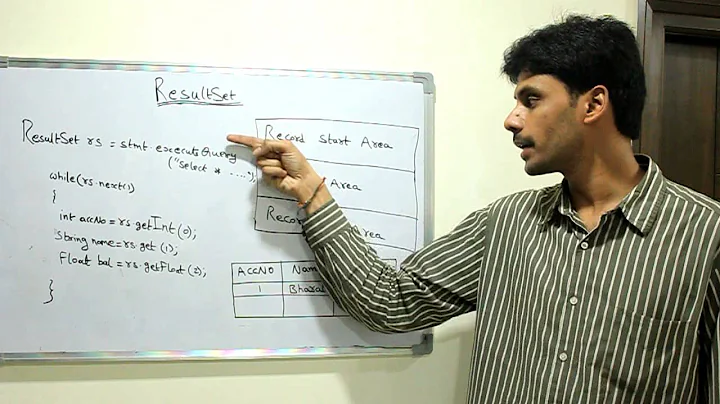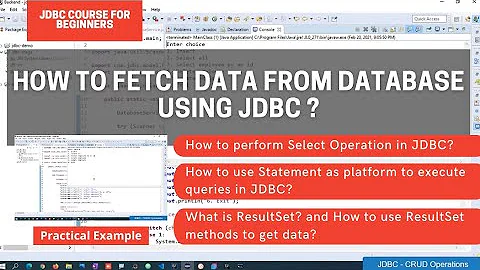How do I get the size of a java.sql.ResultSet?
Solution 1
Do a SELECT COUNT(*) FROM ... query instead.
OR
int size =0;
if (rs != null)
{
rs.last(); // moves cursor to the last row
size = rs.getRow(); // get row id
}
In either of the case, you won't have to loop over the entire data.
Solution 2
ResultSet rs = ps.executeQuery();
int rowcount = 0;
if (rs.last()) {
rowcount = rs.getRow();
rs.beforeFirst(); // not rs.first() because the rs.next() below will move on, missing the first element
}
while (rs.next()) {
// do your standard per row stuff
}
Solution 3
Well, if you have a ResultSet of type ResultSet.TYPE_FORWARD_ONLY you want to keep it that way (and not to switch to a ResultSet.TYPE_SCROLL_INSENSITIVE or ResultSet.TYPE_SCROLL_INSENSITIVE in order to be able to use .last()).
I suggest a very nice and efficient hack, where you add a first bogus/phony row at the top containing the number of rows.
Example
Let's say your query is the following
select MYBOOL,MYINT,MYCHAR,MYSMALLINT,MYVARCHAR
from MYTABLE
where ...blahblah...
and your output looks like
true 65537 "Hey" -32768 "The quick brown fox"
false 123456 "Sup" 300 "The lazy dog"
false -123123 "Yo" 0 "Go ahead and jump"
false 3 "EVH" 456 "Might as well jump"
...
[1000 total rows]
Simply refactor your code to something like this:
Statement s=myConnection.createStatement(ResultSet.TYPE_FORWARD_ONLY,
ResultSet.CONCUR_READ_ONLY);
String from_where="FROM myTable WHERE ...blahblah... ";
//h4x
ResultSet rs=s.executeQuery("select count(*)as RECORDCOUNT,"
+ "cast(null as boolean)as MYBOOL,"
+ "cast(null as int)as MYINT,"
+ "cast(null as char(1))as MYCHAR,"
+ "cast(null as smallint)as MYSMALLINT,"
+ "cast(null as varchar(1))as MYVARCHAR "
+from_where
+"UNION ALL "//the "ALL" part prevents internal re-sorting to prevent duplicates (and we do not want that)
+"select cast(null as int)as RECORDCOUNT,"
+ "MYBOOL,MYINT,MYCHAR,MYSMALLINT,MYVARCHAR "
+from_where);
Your query output will now be something like
1000 null null null null null
null true 65537 "Hey" -32768 "The quick brown fox"
null false 123456 "Sup" 300 "The lazy dog"
null false -123123 "Yo" 0 "Go ahead and jump"
null false 3 "EVH" 456 "Might as well jump"
...
[1001 total rows]
So you just have to
if(rs.next())
System.out.println("Recordcount: "+rs.getInt("RECORDCOUNT"));//hack: first record contains the record count
while(rs.next())
//do your stuff
Solution 4
int i = 0;
while(rs.next()) {
i++;
}
Solution 5
I got an exception when using rs.last()
if(rs.last()){
rowCount = rs.getRow();
rs.beforeFirst();
}
:
java.sql.SQLException: Invalid operation for forward only resultset
it's due to by default it is ResultSet.TYPE_FORWARD_ONLY, which means you can only use rs.next()
the solution is:
stmt=conn.createStatement(ResultSet.TYPE_SCROLL_INSENSITIVE,
ResultSet.CONCUR_READ_ONLY);
Related videos on Youtube
Comments
-
Jake over 3 years
Shouldn't this be a pretty straightforward operation? However, I see there's neither a
size()norlength()method.-
Slamice about 12 yearsI would love to know the reason for that omission.
-
 DejanLekic over 11 yearsMy understanding of the question was that you want to find the size of the ResultSet IN BYTES, not the number of tuples...
DejanLekic over 11 yearsMy understanding of the question was that you want to find the size of the ResultSet IN BYTES, not the number of tuples... -
 AndreaTaroni86 over 4 yearsIt's very annoying to have not the right dimension before process data, but if you have to store them in an array, you can consider using a data structure like List and then convert them to an array with the toArray() method.
AndreaTaroni86 over 4 yearsIt's very annoying to have not the right dimension before process data, but if you have to store them in an array, you can consider using a data structure like List and then convert them to an array with the toArray() method.
-
-
JeeBee over 15 yearslast() and getRow() aren't static methods in the ResultSet class.
-
 laz over 15 yearsFor brevity's sake I always reference methods in this fashion when writing about them to others, regardless of whether they are static or not. Actually creating an instance of the object and calling the method is implied.
laz over 15 yearsFor brevity's sake I always reference methods in this fashion when writing about them to others, regardless of whether they are static or not. Actually creating an instance of the object and calling the method is implied. -
Tofystedeth over 15 yearsInside the if(rs.last()) code block, wouldn't the correct method be rs.beforeFirst() instead of rs.first()? This way, you are not skipping the first record in your result set for processing in the while loop.
-
Jake almost 13 yearsI write SomeClass.staticMethod() and SomeClass#instanceMethod() for less confusion.
-
Naftuli Kay almost 13 yearsHow does one fetch the value returned when executing a
select count? -
Saurabh almost 13 years@TK Kocheran, same way you would get the result of any one-row/one-column query, with
executeQuery(),next()andgetInt(1) -
Marius Ion almost 12 years
ResultSet#last()doesn't work on all types ofResultSetobjects, you need to make sure you use one that is eitherResultSet.TYPE_SCROLL_INSENSITIVEorResultSet.TYPE_SCROLL_SENSITIVE -
Giovanni Botta almost 11 yearsWhat if the result set is returned from a stored procedure call? Is there no way to know its size beforehand?
-
Saurabh almost 11 years@Giodude, the
SELECT COUNT(*)would need to be performed inside the stored procedure, or the stored procedure could return a temporary view and the caller could doSELECT COUNT(*)on that. -
Giovanni Botta almost 11 yearsWhat if you can't change the stored proc because it comes from somewhere else?
-
Saurabh almost 11 years@Giodude, it may not be possible to efficiently count the rows in that case. But if you must manually count the rows, I would do it on the server side if possible (e.g. with a temporary procedure.)
-
ppeterka almost 11 yearsYeah, that works. But I think the OP struggles with knowing the number of rows before actually processing them. Real life reasons I'd have to fight this issue so far: 1.) paging of record rows 2.) showing the rows processed in long-running tasks for progress monitoring purposes...
-
Unai Vivi almost 11 yearsSwitching from
ResultSet.TYPE_FORWARD_ONLYtoResultSet.TYPE_SCROLL_INSENSITIVEusually incurs in a huge performance penalty. -
Joseph Lust over 10 yearsPreallocating data structure size are another reason. I've seen plenty of libs return 10 element Lists when there is only a single value because the dev's had this same issue with ResultSet.
-
 ryvantage over 10 yearsDoes anyone know why getting the count for a resultset is so difficult? Why didn't they just include a
ryvantage over 10 yearsDoes anyone know why getting the count for a resultset is so difficult? Why didn't they just include aResultSet#size()method in the API? -
 Panu Haaramo almost 10 yearsNot working with Tomcat/MySQL:
Panu Haaramo almost 10 yearsNot working with Tomcat/MySQL:java.lang.ClassCastException: org.apache.tomcat.dbcp.dbcp.DelegatingResultSet cannot be cast to com.mysql.jdbc.ResultSetImpl -
Mark Rotteveel over 9 years@ryvantage A bit late. They don't do that, because the count is not known in advance, only after materializing the entire result set does the database know how many rows it produced. This is inefficient as materializing all rows takes memory, I/O and processing time. When reading a forward-only result set (and sometimes also scrollable result sets), a database will only read rows when asked to do so (and it might read a bit ahead). So a client might process some rows, while the database is reading some more: efficient and less memory-intensive.
-
 ryvantage over 9 yearsSo does that mean
ryvantage over 9 yearsSo does that meanselect count(*) from tableis a O(n) operation? -
 ryvantage over 9 yearsAlso, other answers have indicated using
ryvantage over 9 yearsAlso, other answers have indicated usingResultSet::last()as a way to find the count. Would thelast()method also be a O(n) operation then? -
Saurabh over 9 years@ryvantage: Yes. In MS SQL Server for example,
ResultSet::last()is O(N) with the (default) forward-only cursor. You can get O(1)last(from the client's point of view) with a scrollable+static cursor. But these cursor types require the server to store the whole keyset in memory. The server does not know in advance that you are going to throw away the results and use only the row count. It has to build the query plan with the assumption that you will consume all the data. -
 Gobliins over 9 yearsdon't you forget to set the cursor back to beforeFirst outside the if block?
Gobliins over 9 yearsdon't you forget to set the cursor back to beforeFirst outside the if block? -
Madeyedexter about 9 yearsI don't understand what is the drawback of using this method to calculate ResultSet size. This is great...no use of an extra SQL parameter. Please comment on this method.
-
Vit Bernatik almost 9 yearsI did test it on my table (10 columns, 187 392 rows). My test did query and load all elements to string. For TYPE_FORWARD_ONLY it took approx 1 second. For TYPE_SCROLL_INSENSITIVE it took approx 7 second. When I used rather
SELECT COUNT(*) FROM default_tblbefore theSELECT COUNT(*) FROM default_tblit took altogether less than 1.5 second. I tested on embedded derby database 10.11.1.1 -
Vit Bernatik almost 9 yearsThis answer indirectly suggests that when you are going to use data afterwards then the
ResultSet.last()is the optimal solution. In fact the speed measurements I did for embedded Derby and H2 databases shows that even when you are using data afterwards it is still faster to just ask databaseSELECT COUNT(*)before and then get your result in modeResultSet.TYPE_FORWARD_ONLY -
user1697575 about 8 yearsInteresting, but how would you dynamically/generically generate first select statements: cast(null as boolean)as MYBOOL, ect? For that you will need metadata of the "select" statement's fields and datatypes, like boolean, char, int, ect...) that might require extra DB trip that will negate all the benefits.
-
Pierre almost 8 yearsPerformance is the keyword here. Imagine your resultset is 100M records then you will see the issue
-
CodePro_NotYet almost 8 yearsAs ResultSet docs say,
getRow()works forTYPE_FORWARD_ONLYResultSets, andbeforeFirst()throws errors for those. Isn't this answer faulty then? -
 Ivo over 7 yearsI want to know the result set size BEFORE processing the results because I need to make an array of the same size beforehand. And, as noted in other answers, scanning all rows twice won't always work.
Ivo over 7 yearsI want to know the result set size BEFORE processing the results because I need to make an array of the same size beforehand. And, as noted in other answers, scanning all rows twice won't always work. -
 BullyWiiPlaza about 7 yearsThis only works when the statement is created with the scroll insensitive option:
BullyWiiPlaza about 7 yearsThis only works when the statement is created with the scroll insensitive option:ps=conn.createStatement(ResultSet.TYPE_SCROLL_INSENSITIVE, ResultSet.CONCUR_READ_ONLY); -
Unai Vivi almost 7 yearsThis is useful when you do have access to all field details and speed is your main concern (and therefore need to stick with a fast
ResultSet.TYPE_FORWARD_ONLY) -
jones-chris over 3 years@Ivo could you not use a List instead of an array because of noticeable performance degradation?
-
 Ivo over 3 years@jones-chris Who knows, this is 3 years ago, I have no clue what I was doing. I hate arrays though, so I assume using a List wasn't possible. Either way, an array should be more performant than a List (unless List methods get optimized by the runtime).
Ivo over 3 years@jones-chris Who knows, this is 3 years ago, I have no clue what I was doing. I hate arrays though, so I assume using a List wasn't possible. Either way, an array should be more performant than a List (unless List methods get optimized by the runtime). -
jbu over 2 yearsfrom the name
getupdatecount, presumably this would only return a number of rows that gets updated, which wouldn't work if the statement is just reading data







